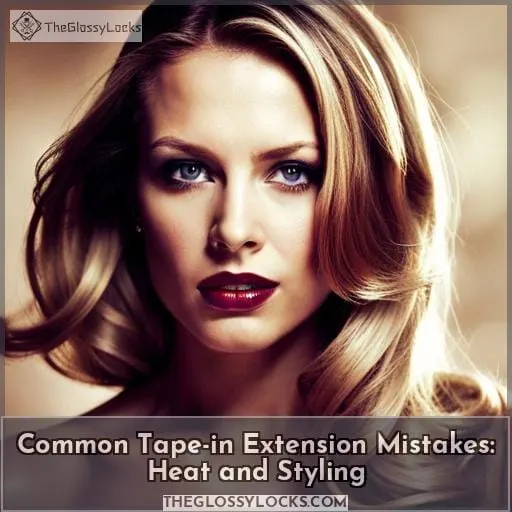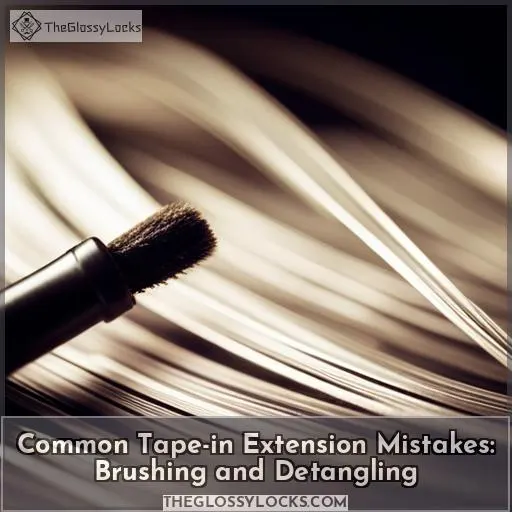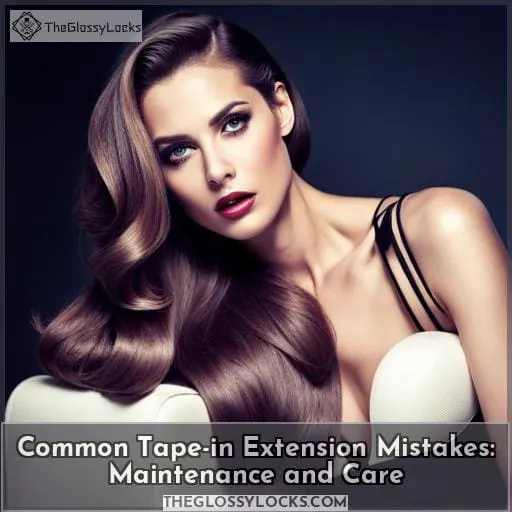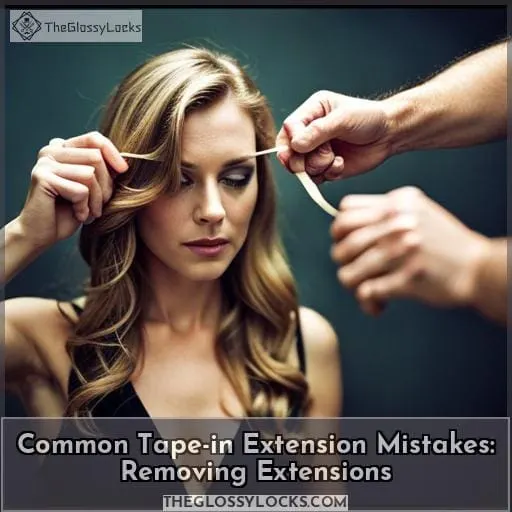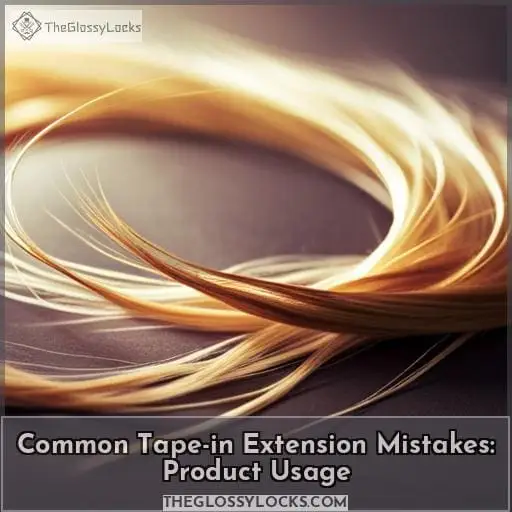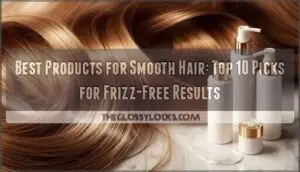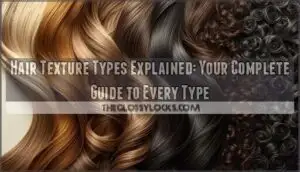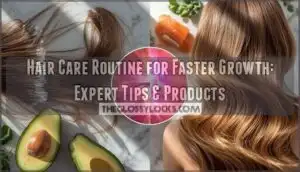This site is supported by our readers. We may earn a commission, at no cost to you, if you purchase through links.
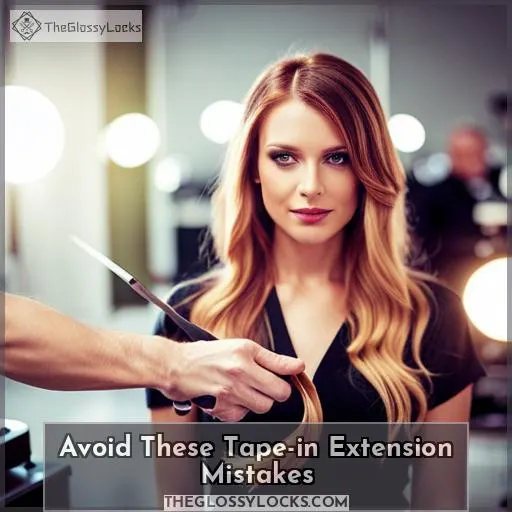 Ready to rock flawless tape-in hair extensions? Avoid these common mistakes that can sabotage your fabulous look.
Ready to rock flawless tape-in hair extensions? Avoid these common mistakes that can sabotage your fabulous look.
From washing and conditioning to styling and maintenance, we’ve got you covered with expert advice. Discover the do’s and don’ts of caring for your extensions, choosing the right type, and removing them properly.
Say goodbye to any worries or mishaps – it’s time for effortless beauty with tape-in hair extensions done right!
Table Of Contents
- Key Takeaways
- Common Tape-in Extension Mistakes: Washing and Conditioning
- Common Tape-in Extension Mistakes: Heat and Styling
- Common Tape-in Extension Mistakes: Brushing and Detangling
- Common Tape-in Extension Mistakes: Maintenance and Care
- Common Tape-in Extension Mistakes: Choosing the Wrong Extensions
- Common Tape-in Extension Mistakes: Removing Extensions
- Common Tape-in Extension Mistakes: Product Usage
- Frequently Asked Questions (FAQs)
- Conclusion
Key Takeaways
- Avoid washing tape-in extensions within 48 hours of installation.
- Use heat protectant and minimize excessive use of heat-styling tools.
- Brush gently and avoid brushing wet extensions.
- Properly prepare natural hair and follow recommended product guidelines.
Common Tape-in Extension Mistakes: Washing and Conditioning
When it comes to tape-in extensions, proper washing and conditioning techniques are crucial for maintaining their longevity and quality.
Avoid making the mistake of washing your hair too soon after installation, as this can weaken the adhesive.
Additionally, over-washing or washing too frequently can lead to dryness and damage.
Lastly, using harsh or improper washing techniques may cause tangling or matting in your extensions.
Taking care to wash and condition correctly will help ensure that your tape-in extensions stay beautiful and intact for longer periods of time.
Washing Too Soon After Installation
One common mistake to avoid with tape-in extensions is washing them too soon after installation.
Proper post-installation care includes:
- Waiting for the adhesive to set.
- Considering scalp sensitivity.
- Ensuring secure extension attachment.
- Allowing an optimal wait time before washing for proper extension maintenance and drying.
Over-washing or Washing Too Frequently
When it comes to tape-in extensions, one common mistake to avoid is over-washing or washing too frequently. Over-washing can lead to dryness and damage the hair extensions, impacting their longevity.
It’s important to find a balance in your extension maintenance schedule that considers your hair health and scalp sensitivity while ensuring proper hydration for both your natural hair and the extensions.
Additionally, protecting the extensions during activities that may cause friction or stress is crucial for maintaining their integrity.
Using Harsh or Improper Washing Techniques
To avoid damaging your tape-in extensions, make sure to use gentle and proper washing techniques.
- Use lukewarm water instead of hot water to prevent loosening the adhesive.
- Choose a sulfate-free shampoo specifically designed for hair extensions.
- Pat dry with a towel and avoid rubbing vigorously.
- Wash your extensions no more than twice a week to maintain their longevity.
Neglecting to Condition Properly
Don’t forget to properly condition your tape-in extensions after washing them.
Conditioning is crucial for maintaining their hydration and preventing dryness or damage.
Use a high-quality conditioner specifically designed for hair extensions, focusing on the mid-lengths and ends.
Incorporate conditioning techniques into your regular hair care routine to keep your extensions moisturized and looking their best.
Common Tape-in Extension Mistakes: Heat and Styling
When it comes to tape-in extensions, heat and styling can be a potential minefield if not approached with caution.
One common mistake to avoid is excessive use of heat-styling tools on your extensions, as this can lead to damage and weaken the adhesive.
Additionally, using high heat settings on your extensions can cause them to become brittle and more prone to breakage.
To protect your tape-in extensions, always remember to use a heat protectant product before applying any kind of direct heat styling.
Excessive Use of Heat-styling Tools
If you frequently use heat-styling tools on your tape-in extensions, you may be making a common mistake that can lead to damage and decreased longevity.
Excessive heat can cause heat damage to both your natural hair and the extensions, resulting in dryness, breakage, and frizz.
To protect your hair health and extend the lifespan of your extensions, it’s essential to minimize heat usage or explore alternative styling methods such as low-temperature styling or creating heat-free styles.
Taking these precautions will help maintain the integrity of your hair while still achieving desired looks with minimal risk.
Using High Heat Settings on Extensions
Avoid using high heat settings on your tape-in extensions to prevent damage and maintain their longevity.
- Heat damage: Excessive heat can cause the hair fibers in your extensions to become brittle and prone to breakage, leading to frizz and a shorter lifespan.
- Temperature control: Using high temperatures can melt or loosen the adhesive used for attaching the extensions, resulting in them slipping or falling out prematurely.
- Lack of heat protectants: Without applying a thermal protectant before using hot tools, the direct contact between the heated plates and your hair can strip away moisture, leaving it dry, dull, and susceptible to further damage.
Not Using Heat Protectant Products
When styling your tape-in extensions, it’s essential to use heat protectant products to safeguard the health and integrity of both your natural hair and the extensions.
Heat protectants create a protective shield against high temperatures, preventing damage and breakage.
Choose a heat protectant specifically designed for hair extensions and apply it before using any hot tools.
This simple step can make a significant difference in maintaining the longevity of your tape-in extensions while ensuring optimal hair health.
Common Tape-in Extension Mistakes: Brushing and Detangling
When it comes to brushing and detangling tape-in extensions, there are a few common mistakes you should avoid:
- First, make sure not to brush your hair extensions like you’d natural hair – be gentle and use the appropriate techniques.
- Additionally, avoid brushing wet extensions as this can cause damage and breakage.
- Lastly, using the wrong type of brush or comb can lead to tangling and matting of the extensions.
By following these tips, you can ensure that your tape-in extensions stay in great condition for longer periods of time.
Brushing Hair Extensions Like Natural Hair
To prevent damage to your tape-in extensions, it’s important to avoid brushing them like you’d natural hair.
Instead, opt for extension-friendly styling techniques that prioritize tension-free brushing.
Use a wide-toothed comb and start from the bottom, working your way up gently to detangle without causing strain or breakage.
This maintenance hack ensures seamless integration and longevity of your extensions while blending with your natural hair effortlessly.
Remember these secrets for proper installation methods and caring for curly extensions as well.
Brushing Wet Extensions
Are you wondering how to properly brush wet tape-in extensions?
Wet brushing can be a delicate process that requires extra care and attention. To avoid damage, start by gently detangling any knots with your fingers or a wide-toothed comb. Then, use a soft-bristle brush to gradually work through the extensions from the bottom up.
Remember to be patient and take your time when brushing wet extensions to prevent breakage and maintain their longevity.
Using the Wrong Type of Brush or Comb
One common mistake is using the wrong type of brush or comb when detangling your tape-in extensions.
To ensure the health and longevity of your extensions, it’s important to choose appropriate brushes and combs.
Opt for a wide-toothed comb that gently glides through the hair without tugging or pulling on the tapes.
Avoid bristle brushes as they can cause damage to both natural hair and extensions.
Using suitable styling tools will help you maintain beautiful, healthy hair while avoiding unnecessary breakage or tangling.
Common Tape-in Extension Mistakes: Maintenance and Care
When it comes to maintaining and caring for your tape-in extensions, there are a few common mistakes that you should avoid:
Firstly, make sure to protect your extensions during activities or sleep by securing them in a low braid or loose ponytail.
Secondly, improper storage of extensions can lead to damage, so be sure to wash them properly and store them flat in an airtight container.
Lastly, neglecting routine maintenance and check-ups can cause issues down the line, so make sure to schedule regular appointments for maintenance every six weeks.
Not Protecting Extensions During Activities or Sleep
Neglecting to protect your tape-in extensions during activities or sleep can lead to unnecessary damage and premature wear.
When exercising, opt for a higher ponytail to minimize sweat and oils on the extensions.
During sleep, protect them by loosely braiding or tying in a low ponytail.
Taking these precautions will help maintain the longevity of your hair extensions.
Improper Storage of Extensions
To ensure the longevity and quality of your tape-in extensions, it’s crucial to store them properly when not in use.
Improper storage can lead to tangling, matting, and damage.
To preserve your extensions, consider using storage hacks like:
- Keeping them flat in an airtight container.
- Hanging them on a hanger with clips.
These maintenance tricks will help extend the life of your hair extensions and keep them looking beautiful for longer.
Neglecting Routine Maintenance and Check-ups
When it comes to maintaining your tape-in extensions, it’s crucial not to overlook the importance of routine maintenance and check-ups.
Regularly scheduling appointments for a routine check-up is essential in ensuring the longevity and health of your extensions.
- Monitoring any potential issues or concerns early on.
- Promoting proper maintenance techniques.
- Addressing them promptly if needed.
Remember to keep your hair dry when possible and remove extensions correctly to avoid further mistakes.
Common Tape-in Extension Mistakes: Choosing the Wrong Extensions
When it comes to tape-in extensions, one of the most common mistakes is selecting extensions with the wrong hair length.
It’s important to choose extensions that are compatible with your natural hair and blend seamlessly for a natural look.
Additionally, failing to properly prepare your hair before application can lead to issues with adhesion and longevity of the extensions.
Selecting Extensions With the Wrong Hair Length
Choosing the right hair length for your tape-in extensions is crucial to achieving a seamless and natural look.
Hair compatibility and blending techniques play a significant role in ensuring that the extensions seamlessly integrate with your natural hair.
During the installation process, proper tape adhesion and length adjustment should be considered to achieve optimal results.
Avoiding these mistakes will help you maintain long-lasting, beautiful tape-in hair extensions.
Not Considering Hair Compatibility and Blending
When selecting tape-in hair extensions, it’s crucial to consider hair compatibility and blending for a seamless and natural look.
Hair blending involves matching the texture of your natural hair with the extensions, ensuring color harmony for a cohesive appearance.
Compatibility checks are essential to ensure proper installation methods and seamless integration of the extensions with your existing hairstyle.
Neglecting these factors can lead to noticeable differences between your natural hair and the extensions, resulting in an unnatural appearance.
Failing to Prepare Hair Properly Before Application
To ensure a seamless and successful application of tape-in extensions, it’s essential to properly prepare your hair beforehand. This involves taking into account factors such as your hair texture, scalp health, and moisture balance.
By following proper installation preparations, you can optimize the longevity and appearance of your tape-in extensions.
- Hair Texture Consideration: Assessing your natural hair texture will help determine the appropriate type of tape-in extensions to choose for a seamless blend.
- Scalp Health: Ensure that your scalp is in good condition by addressing any issues like dandruff or irritation before applying extensions.
- Moisture Balance: It’s crucial to maintain optimal moisture levels in both your natural hair and the extension adhesive area for better adhesion.
By thoroughly preparing these aspects prior to installing tape-in extensions, you set yourself up for an improved overall experience with minimal damage or discomfort during wear.
Common Tape-in Extension Mistakes: Removing Extensions
When it comes to removing tape-in extensions, it’s important to take your time and avoid rushing or pulling them out forcefully.
Additionally, using the proper adhesive remover is crucial for a safe removal process.
Neglecting to seek professional help when removing extensions can also result in mistakes that may lead to unwanted hair breakage or tangling.
Rushing or Pulling Extensions During Removal
Are you in a rush to remove your tape-in extensions?
It’s crucial to approach the removal process with gentle care and proper technique. Rushing or pulling at the extensions can lead to damage, compromising both hair health and extension integrity.
Take your time when removing them, ensuring that you maintain bond strength while minimizing any scalp gap.
Following proper installation methods will also contribute to easier and safer removal of tape-in extensions.
Not Using Proper Adhesive Remover
If you’re removing tape-in extensions, make sure to use the proper adhesive remover.
Using the wrong adhesive remover can lead to complications such as:
- Residue left behind
- Damage to your natural hair
Adhesive sensitivity is also a concern, so selecting a suitable product is crucial.
After removal, it’s important to take care of your hair with post-removal care and follow proper installation methods for future extension applications.
Avoid these mistakes by using the right products and techniques for removing tape-in extensions correctly.
Neglecting to Seek Professional Help for Removal
Don’t underestimate the importance of seeking professional help when it comes to removing your tape-in extensions.
- Professional assistance ensures safe and proper removal techniques.
- Avoid the risks associated with DIY removal, such as pulling or tugging on your natural hair.
- Expertise in extension removal prevents potential harm to your scalp or existing hair.
- Seek professional advice for a smooth transition from installed extensions back to natural hair.
Common Tape-in Extension Mistakes: Product Usage
When it comes to tape-in extensions, using the right products is crucial for maintaining their longevity and overall health.
One common mistake to avoid is using products that contain harmful ingredients, such as sulfates or alcohol, which can strip the hair and damage the adhesive.
Additionally, using products that cause buildup or leave a residue on the extensions can lead to matting and tangling.
It’s important to follow recommended product guidelines provided by your stylist or extension manufacturer for optimal results.
Using Products With Harmful Ingredients
To ensure the longevity and health of your tape-in extensions, it’s crucial to steer clear of using products with harmful ingredients.
Conduct thorough ingredient analysis before purchasing any hair care product to avoid potential chemical impact on your extensions.
Stay informed about safe alternatives and make conscious choices when it comes to product selection for maintaining the quality of your tape-in hair extensions.
Using Products That Cause Buildup or Damage
Avoid using products that can cause buildup or damage to your tape-in extensions.
When selecting products for your extensions, opt for extension-friendly options that are specifically formulated to prevent buildup and contain gentle ingredients.
Look for cleansers and conditioners that are sulfate-free, as sulfates can strip the hair of its natural oils and lead to dryness and frizz.
Avoid products with damaging ingredients such as alcohol or harsh chemicals.
Proper product selection is crucial in maintaining the longevity and health of your tape-in extensions.
Not Following Recommended Product Guidelines
If you frequently overlook the recommended product guidelines for tape-in extensions, you may unintentionally cause damage or buildup to your hair. It’s crucial to follow usage guidelines and select products that are compatible with your extensions.
Avoid product missteps by being aware of ingredient labels and using recommended products specifically designed for tape-in hair extension care.
Proper installation methods and removing extensions correctly also play a significant role in maintaining their longevity.
Frequently Asked Questions (FAQs)
Can I wash my hair immediately after getting tape-in extensions?
You should avoid washing your hair immediately after getting tape-in extensions to ensure proper adhesion.
It’s recommended to wait at least 48 hours before washing, allowing the adhesive to fully bond with your natural hair for long-lasting results.
Is it safe to use heat styling tools on tape-in extensions?
Using heat styling tools on tape-in extensions is generally safe, but caution should be exercised.
Like a skilled conductor leading an orchestra, regulate the temperature and use a heat protectant to prevent damage and maintain the longevity of your extensions.
Can I brush my tape-in extensions when they are wet?
Yes, you can brush your tape-in extensions when they’re wet.
However, it’s important to avoid pulling or tugging on the hair while wet and use a wide-toothed comb for gentle brushing.
How often should I have my tape-in extensions maintained?
To maintain the quality and longevity of your tape-in extensions, it’s recommended to schedule maintenance appointments every six weeks. This ensures comfortable wear and efficient upkeep for a seamless extension experience.
What types of products should I avoid using on tape-in extensions?
To maintain the longevity and quality of your tape-in extensions, it’s crucial to avoid using products with silicone near the adhesive area. Additionally, steer clear of harsh shampoos or conditioners that may lead to matting or damage.
Conclusion
Say goodbye to hair extension mishaps and hello to flawless tape-in hair extensions.
[Keypoints]By avoiding common mistakes, such as:
- Washing too soon after installation
- Excessive heat styling
- Improper brushing techniques
- Neglecting routine maintenance
you can maintain the perfect look.
Make sure to:
- Choose the right extensions for your hair
- Prepare properly before application
- Seek professional help when removing them
Additionally, using the right products and following recommended guidelines will ensure your extensions stay healthy and beautiful.
So rock your tape-in extensions with confidence and enjoy effortless beauty.


